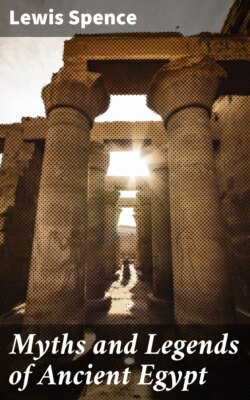Читать книгу Myths and Legends of Ancient Egypt - Lewis Spence - Страница 28
На сайте Литреса книга снята с продажи.
Palaces and Mansions
ОглавлениеThe palaces and mansions of the wealthy and great generally stood in the midst of a garden or courtyard planted with trees surrounded with crenellated walls, broken only by a doorway, which often indicated the social importance of the family. At times it was a portico supported on columns and adorned with statues; at others, a pylon similar to those at the entrance of temples. "The interior," says Maspero, "almost resembled a small town divided into quarters by irregular walls. In some cases the dwelling-house stood at the farther end; while the granaries, stables, and domestic offices were distributed in different parts of the enclosure." Paintings and plans on walls of tombs, the remains of houses at Tell el Amarna and of the palace of Akhenaten, have supplied the means by which we learn these details. The pictorial plan of a Theban house, half palace, half villa, is thus elucidated by Maspero: "The enclosure is rectangular, surrounded by a crenellated wall. The principal entrance opens upon a road bordered by trees by the side of a canal or branch of the Nile. The garden is symmetrically divided by low stone walls. In the centre is a large trellis supported on four rows of small columns; to right and left are four pools stocked with ducks and geese, two leafy conservatories, two summer-houses, and avenues of sycamores, date-palms, and dôm-palms. At the back, facing the entrance, is the house, two-storied and of small dimensions, surmounted by a painted cornice." On one of the tombs of Tell el Amarna is to be found a representation of the palace of Aï, who later ascended the throne of Egypt. This is of large size, rectangular in shape, the façade wider than the sides. The staircases running to the terraced roof lead into two small chambers at each corner of the back wall. The dwelling-house itself is contained within this outer building, and was sacred to the family and its head, and only intimate friends had the right of entrance. The remains of the ruined palace of Akhenaten at Tell el Amarna also follows much the same plan, with the addition of a pavilion for the queen's use, containing a large hall 51 feet by 21 feet. In this palace was another immense hall, its dimensions being 423 feet by 234 feet. It contained 542 mud pillars, 52 inches square. It communicated with five smaller halls. "The pillars were whitened, and the ceilings were painted with vine-leaves and bunches of grapes on a yellow ground." Many of the mansions and houses afford some beautiful specimens of the decorative art of those days. Remains of the domestic architecture of the Old Kingdom are not numerous, but the general plan seems to have been much the same as in the later periods. The small antiquities discovered, such as utensils, clothes, weapons, amulets, and other articles which have been found in great numbers, fill in the picture of the domestic life of ancient Egypt; while temple and fortress and monument tell of the religion, the warfare, and the enterprise in that distant epoch.
These excavations cover a large area. Upper, Middle, and Lower Egypt and Nubia have been extensively explored, likewise the Sinai Peninsula and Syria, with its numerous tablets of conquest. In Nubia, states an authority, owing to the poverty of the country and its scanty population, the proportion of monuments surviving is infinitely greater than in Egypt. Many temples, tombs, quarries, forts, grottos, and pyramids have been found in a good state of preservation. In Upper Egypt are to be found the great pyramids and the necropolis of Memphis, with various smaller pyramids to the south, and it also boasts of the stupendous ruins of Thebes on both sides of the river, the tombs and quarries of Assuan, and the temples of Philæ, though these by no means exhaust the list of sites which have been excavated, while it is well known that many still hold mysteries as yet untouched.
